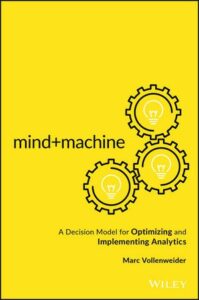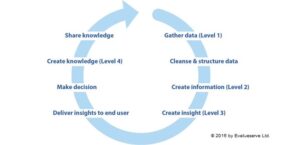Google the search team “data analytics” and you’ll see at least 6.1 million search results. “Big data” will give you more than twice as many. Suffice it to say that the “hype cycle” for this knowledge domain is in full swing.
But in my experience as a non-technical, non-financial business manager, the topic of analytics can be a bit mystifying. It’s easy to see the potential, but difficult to understand how to implement – or where to start.
To the rescue comes Marc Vollenweider, CEO of Evalueserve, a global provider of research, analytics and data management solutions. (Full disclosure: I’ve been a client of Evalueserve and respect their capabilities).
Vollenweider’s new book, Mind+Machine – A decision model for optimizing and implementing analytics is the most on-point, down-to-earth work I’ve seen on data & an alytics, or D+A in the jargon. It offers a businessperson’s view of this complex topic, with easily digestible insights and practical suggestions on how to put analytics to work in solving day-to-day business problems.
alytics, or D+A in the jargon. It offers a businessperson’s view of this complex topic, with easily digestible insights and practical suggestions on how to put analytics to work in solving day-to-day business problems.
The book starts by debunking some common misconceptions about analytics. One that resonated for me was “Analytics is Just an Analytics Challenge”. Clearly it’s not, says Vollenweider. Far more important than the analytics themselves is how they will be used. How can you efficiently deliver the right analytics to the right people at the right time? And, how do you reorient your people and organization so the analytics are used to inform real business decisions, rather than piling up more data?
Vollenweider’s concept of the “Ring of Knowledge” gives us a useful way of looking at the analytics value chain, and determining the right mix of “mind” and “machine” based approaches.

Too often, analytics projects focus at the start of the ring – where data is processed, rather than the end, where business decisions are made and the knowledge codified. “Decision makers really want the compressed insight and the knowledge, not the data or even the information,” Vollenweider states.
For me, the book’s best feature is the Use Case methodology used to describe D+A applications. The book includes dozens of use cases, each structured in a consistent framework that describes the business problem, the approach used to solve it, the challenges, the benefits experienced, and basic implementation details. The use cases cover multiple business functions and industries – there’s no shortage of practical insights here for managers across all domains.
What’s really interesting to me is that most of the use cases in this book are not about applications of Big Data. In fact, Vollenweider states that 95% of them are about small data – pinpoint applications of analytics to achieve large impacts. In one of the book’s most vivid examples, an investment bank was able to save $1,000,000 annually on database licences by applying 800 bits of code. How? I don’t want to spoil it for you, so read the book to find out!
Mind+Machine is a must-read for any businessperson who wants to understand how to get started with D+A – and where to prioritize D+A effort to get results. It’s available from Amazon in physical and e-book formats.






